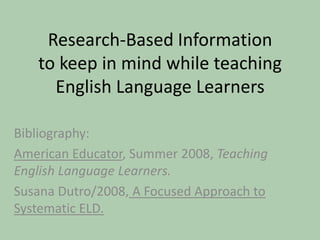
Research-Based Strategies to Help English Language Learners Succeed
- 1. Research-Based Informationto keep in mind while teaching English Language Learners Bibliography: American Educator, Summer 2008, Teaching English Language Learners. Susana Dutro/2008, A Focused Approach to Systematic ELD.
- 2. Achievement Gap for ELLs 2007 National Assessment of Educational Progress, Fourth Grade ELLs: * scored 36 points below non-ELLs in reading. * scored 25 points below non-ELLs in math. Eighth grade scores: 42 points below in reading 37 points below in math
- 3. Statistics 1990 – 1 in 20 students 2008 – 1 in 9 students 2028 – demographers project 1 in 4 students 80% of ELLs are Spanish speakers *24% are from families below poverty level before immigrating. *Less than 40% of the adult immigrants have a high school education. *87.5% of ELL population were born in the US. Language and socioeconomic factors put ELLs at risk of poor educational outcomes.
- 4. CREDE ReviewA report on researched findings about educating English language learners: *Teaching students to read in their L1 promotes higher levels of reading in English. *What we know about good instruction and curriculum in general holds true for ELLs as well; but *When instructing ELLs in English, teachers must modify instruction, taking into account students ‘ language limitations.
- 5. Overview of English Proficiency Levels Beginning: Student uses gestures, learns high-frequency words and basic phrases. Effective Instructional Practices: *Exposure to abundant basic vocabulary supported with visuals and realia. *Making explicit connections to known vocabulary/concepts in L1 if possible. *Model simple sentence patterns. *Provide many repetitions.
- 6. Early intermediate: Student learns to use routine expressions independently, responds orally/writing using simple sentences when provided scaffold. Effective Instructional Practices: *Give extensive practice in variety of ways to communicate thoughts. *Provide instructional feedback. *Repetitive and patterned text extends grammatical forms practice. *Begin building standard content vocabulary around standard content themes.
- 7. Intermediate: Student learns to use a variety of verb tenses and grammatical structures, express ideas, describe events, give information orally/writing, comprehend basic content learning. (All using scaffolds) Suggested Teaching Strategies: *Focus on array of academic purposes. *Explore word relationships: word sorts/graphic organizers. *Increasingly precise vocabulary using frames, stems … Exposure to varied and extended texts with scaffolds. *Build English content vocabulary within thematic content.
- 8. Early Advanced: Student initiates and sustains spontaneous language interactions Is able to comprehend increasingly complex oral and written material. Uses academic vocabulary to represent thoughts. Effective Instructional Practices: *Consistent exposure to complex narrative and expository text, focused on comprehension. *Develop academic vocabulary and complex tenses. *Address persistent problem areas in grammar. *Discuss and use metaphoric and figurative language. ,
- 9. Advanced: The student comprehends general and implied meanings. Writes for social and academic purposes, although expression is sometimes stilted. Have mastered language conventions for formal and informal use. Effective Instructional Practices: *Repeated opportunities to express thinking about abstract concepts. *Authentic practice opportunities to develop fluency and automaticity in communication. *Direct instruction of finer, more subtle points of usage.
- 10. Addressing the needs of ELLs through Research- Based Strategies will: Help to close the wide learning gap between Ells and English speaking students. Benefit L1 and L2 students through best Instructional practices. Reduce the costs of large scale under- achievement in the future of US society. If any of these arguments appeals to you, then Advocate for research-based, ESOL instruction.